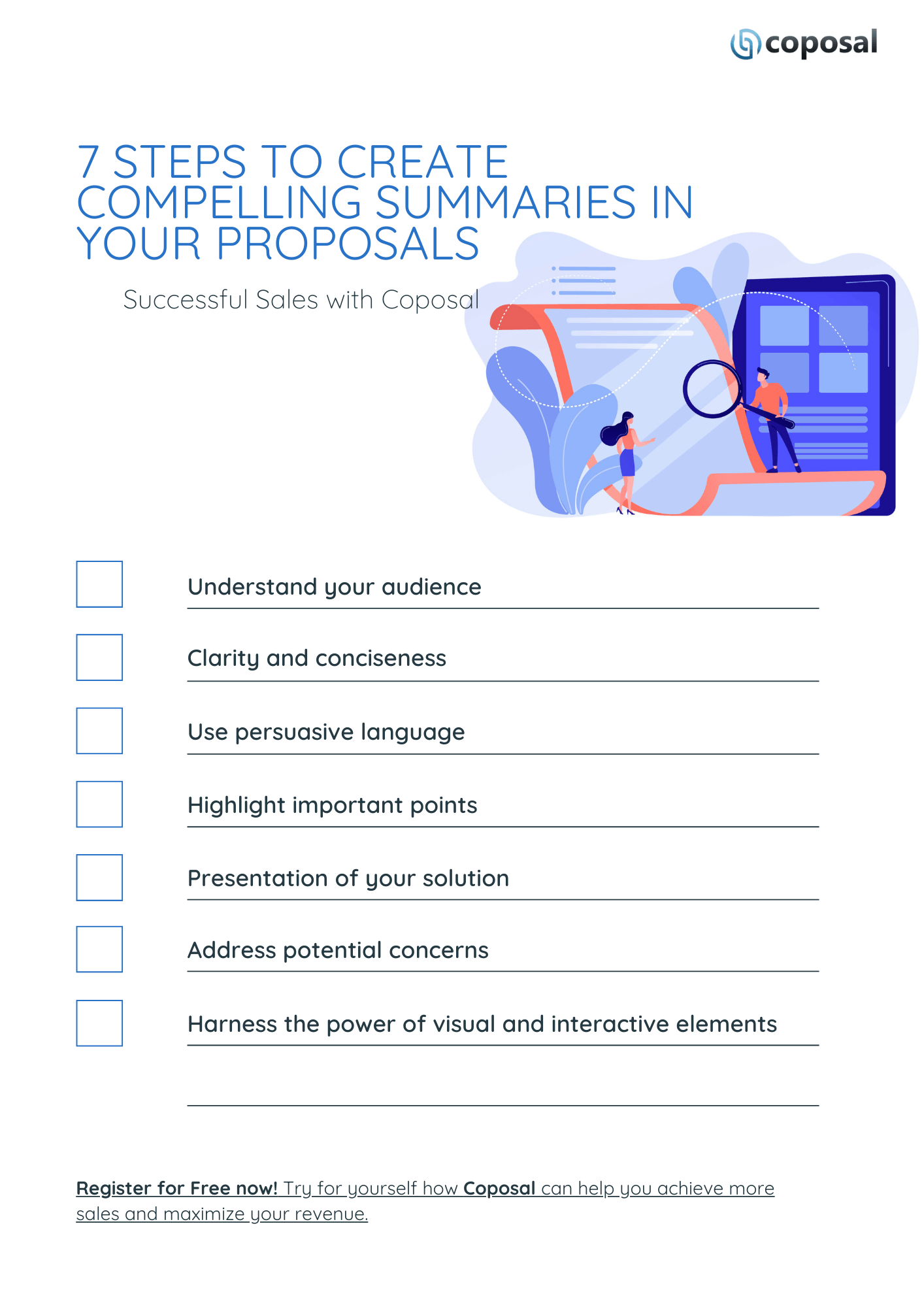 In business, the ability to formulate convincing proposals is essential. No matter whether you are proposing a new project, looking for financing or applying for a lucrative contract: the structure and content of your offer play a crucial role in its success.
In business, the ability to formulate convincing proposals is essential. No matter whether you are proposing a new project, looking for financing or applying for a lucrative contract: the structure and content of your offer play a crucial role in its success.
In this comprehensive guide, we'll go over 7 crucial steps to help you create summaries that resonate with your audience and help your proposals succeed.
Crafting compelling proposals that captivate, persuade and inspire action requires a strategic approach and a deep understanding of your target audience's needs and preferences.
Table of Contents
Understand your audience
Before you pen down a single word, it is essential that you understand your audience inside and out.
- Identification of stakeholders/target group: Who is your target group or who are the most important decision makers or stakeholders involved in the process of evaluating your proposal?
- Analyze preferences: What are their pain points, preferences and priorities? By carefully analyzing your target audience's profile, you can tailor your proposal to address their specific needs and interests.
Clarity and conciseness
When it comes to summaries, brevity is important. To ensure your message is understood quickly and accurately, clarity and conciseness are of utmost importance. Avoid jargon and convoluted sentences and instead opt for clear language that conveys your ideas succinctly.
- Remember: In the fight for attention, every word counts. Cut the fat, get to the point, and watch your summaries convince.
 Reading recommendation: Find out more about the "The Significance of Clear and Concise Language in Proposals" in our blog article.
Reading recommendation: Find out more about the "The Significance of Clear and Concise Language in Proposals" in our blog article.
Use persuasive language
 The summary serves as a gateway to your offering and provides a concise overview of the key highlights and value proposition.
The summary serves as a gateway to your offering and provides a concise overview of the key highlights and value proposition.
Use the power of persuasive language to add conviction and charisma to your summaries.
Use rhetorical devices such as parallelism, repetition, and rhetorical questions to evoke emotion and inspire action.
- Captivate your audience: Capture your reader's attention right from the start with a compelling hook that gets to the heart of your offer.
- Highlight benefits: Clearly articulate the benefits and outcomes your proposal will deliver and emphasize the value proposition to your audience.
Highlight important points
 In a flood of information, it can easily happen that important details are lost. To prevent this, strategically highlight key points in your summary.
In a flood of information, it can easily happen that important details are lost. To prevent this, strategically highlight key points in your summary.
Whether it's a breakthrough innovation, a competitive advantage, or a compelling statistic, draw attention to these elements to keep your audience interested.
By signaling what's most important, you direct the reader's attention and leave a lasting impression.
Presentation of your solution
The essence of the summary is to present a solid solution that specifically addresses the identified problem or opportunity.
- Methodology: Explain the approach, methods and strategies you will use to achieve the desired results.
- Value Proposition: Articulate your solution's unique selling points and competitive advantages and highlight how it stands out from alternative approaches.
Address potential concerns
Anticipating and addressing potential problems demonstrates foresight and proactive problem-solving skills.
- Risk Mitigation: Identify potential risks, challenges, or objections that stakeholders may raise and outline risk mitigation strategies to address them.
- Frequently Asked Questions: Preemptively address common questions or concerns and demonstrate your willingness to engage and clarify any uncertainties.
 Reading recommendation: Our Blog article shows you "5 Strategies for Addressing Potential Objections in Your Proposal Content"
Reading recommendation: Our Blog article shows you "5 Strategies for Addressing Potential Objections in Your Proposal Content"
Harness the power of visual and interactive elements
Incorporating visually appealing elements into the summary of your offers can improve understanding, retention, and engagement.
- Infographics: Condense complex information into easy-to-understand visual representations such as infographics, charts, and diagrams to convey key points at a glance.
- Interactive Elements: Incorporate interactive elements to bring your proposal to life and engage multiple senses.
 Recommended reading: In our article “The Power of Visual Elements in Proposals”, we explore the benefits of incorporating visual elements into your offers and clarify why they are essential for success.
Recommended reading: In our article “The Power of Visual Elements in Proposals”, we explore the benefits of incorporating visual elements into your offers and clarify why they are essential for success.
Summary
When creating offers, the focus is on the summary.
By mastering the art of writing compelling summaries, you can transform complex ideas into digestible insights that resonate with your audience.
Whether you're competing for funding, proposing a project, or courting potential clients, the ability to communicate persuasively is a skill that will serve you well in any endeavor.
Remember that a well-crafted summary doesn't just reflect your ideas; It is a gateway to success.
 Reading tip: If our article helped you and you would like to find out more about the structure and content of proposals, you can find further information here: "Mandatory information in proposals - What should not be missing under any circumstances"
Reading tip: If our article helped you and you would like to find out more about the structure and content of proposals, you can find further information here: "Mandatory information in proposals - What should not be missing under any circumstances"
Frequently asked questions about summarizing offers
How do I make sure my summary resonates with my audience?
The key is understanding your audience. Tailor your summary to their needs, preferences, and expertise to foster deeper connection and engagement.
What role does clarity play in a summary?
Clarity is of the utmost importance. Use clear language to convey your ideas succinctly and ensure your message is understood quickly and accurately.
How can I address potential concerns in my summary?
Anticipate concerns and offer compelling counterarguments to proactively neutralize them. Show foresight and empathy towards the concerns of your target group.
What should I do after I create my summary?
Seek feedback from trusted colleagues or mentors to gain valuable insight and perspective. Use constructive criticism as an opportunity for growth and gradually refine your summaries until they shine with clarity and persuasiveness.
Why is feedback so important in the summary creation process?
Feedback is the lifeline of improvement. Ask for feedback to gain new perspectives and identify opportunities for improvement. Here's how to make sure your summaries are perfect.